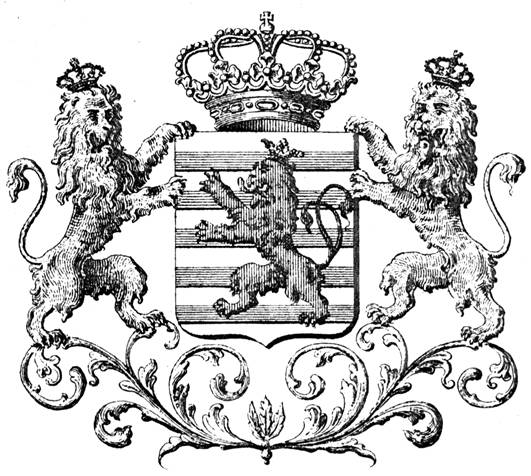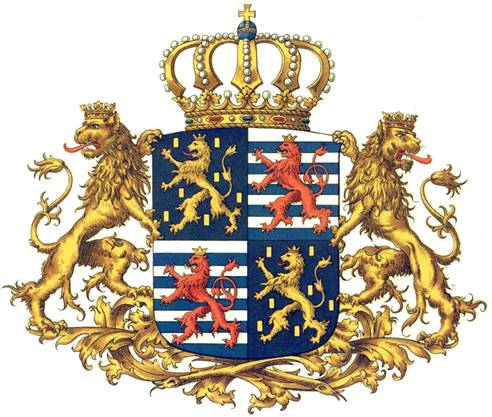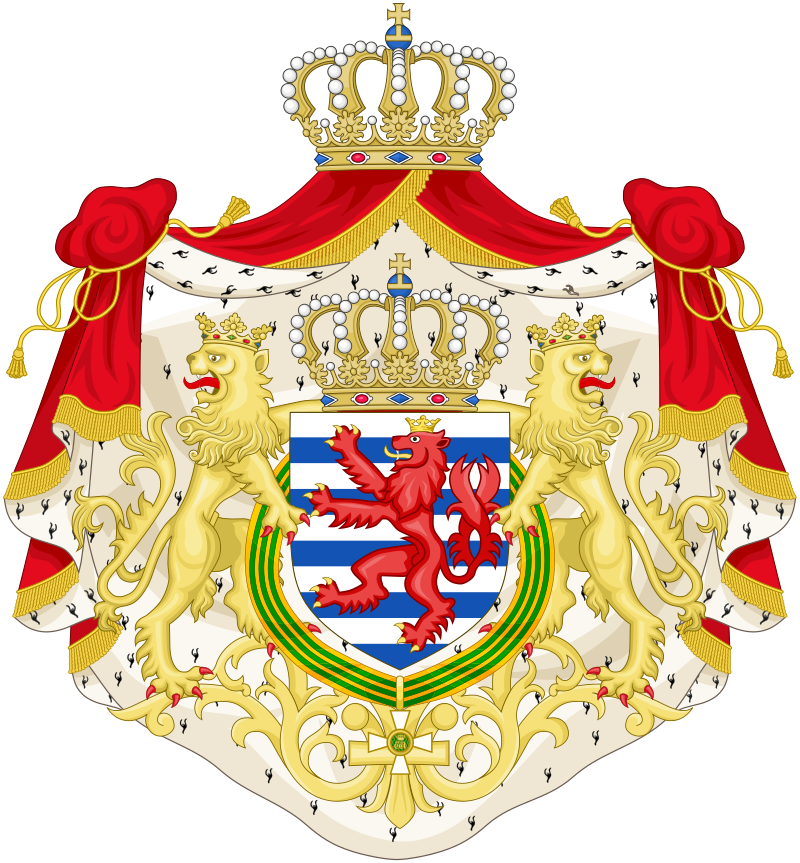Not surprisingly, Luxembourg's Supporters are two golden Lions, following the pattern of many European monarchies. They are the exact mirror image of each other wearing heraldic crowns, looking away from the Shield (presumably, like in Sweden, to be seen to 'guard' the Shield) and both have a tail which is split in two. (This as opposed to having two tails which would be slightly but distinctively different.)
For a long time Luxembourg's Arms didn't have Supporters. The area was simply a county, governed by a Count, and was not raised to a Grand Duchy until the Congress of Vienna in 1815 in personal union with the Kingdom of the Netherlands. In 1830, Luxembourg joined the Belgian Revolt and nine years later, the great powers decided to split the Grand Duchy. The western part became a province of Belgium and the eastern half remained in personal union with the Netherlands but with separate status.
When William III died in 1890 he had no surviving sons. The Dutch Throne happily passed on to his daughter, Wilhelmina, but the Nassau Family Pact deemed that Luxembourg was governed by Salic Law which meant that women could only succeed if the male line had been exhausted. The Duke of Nassau himself, Adolphe/Adolf, was the nearest male heir. The ageing Duke had seen his Duchy annexed to Prussia in 1866 and so was Duke in name only. However, even though he was 73, he was the ideal choice as he had, in fact, taken over the regency of Luxembourg for a short time during William III's illness.
Adolphe issued a decree on 29th July 1898 regarding the Grand Ducal Arms that a new description would replace the Arms used up until then.
Schildhalter: Zwei auf gelben Ranken stehende, rückwärts schauende gelbe Löwen mit heraldischen Kronen.
Supporters: Two Lions regardant crowned or standing on tendrils also or.
Henry V, son of the Duke of Limburg, became the Count of Luxembourg by right of his mother, Ermesinde, in the 13th Century. Limburgs's Arms were a red crowned Lion with a forked tail on a plain white background. To tell the difference, Henry adopted a red crowned Lion with just one tail and changed the background (or Field) to white and blue stripes. Henry's elder brother, also Henry, succeeded to the Limburg title but his son had no male heir and so, in 1282, Henry V of Luxembourg's son, also Henry, inherited Limburg as well. To represent the two titles joined back together in the one person, the Lion on the Shield of Luxembourg was changed to having a forked tail as well. Tradition says that the two ends of the tail are crossed in saltire, although this is sometimes missed by artists.
Jean's decree of 1972 had the effect that the country's Supporters had forked/split tails but the Grand Ducal family's didn't. The family largely continued, as they had done before, using different variations.
Jean abdicated in October 2000 and was succeeded by his son Henri who issued a decree on 13th February 2001 which, amongst other things, fixed the Supporters to the Grand Duke's medium Arms as follows:
Supports, à dextre un lion couronné d'or, la tête contournée, la queue fourchue et passée en sautoir, armé et lampassé de gueules, à senestre un lion couronné d'or, la tête contournée, armé et lampassé de gueules.
Supporter: Dexter, a Lion regardant queue forché and passed in saltire crowned or, armed and langued gules; Sinister, a Lion regardant queue forché and passed in saltire crowned or, armed and langued gules.
A few months later, on 23rd June 2001, Henri issued a decree for the large Coat of Arms, as shown at the top of the page, by which each Lion Supporter carried a Lance from which flies a Luxembourg Flag with gold fringing.




 RSS Feed
RSS Feed
